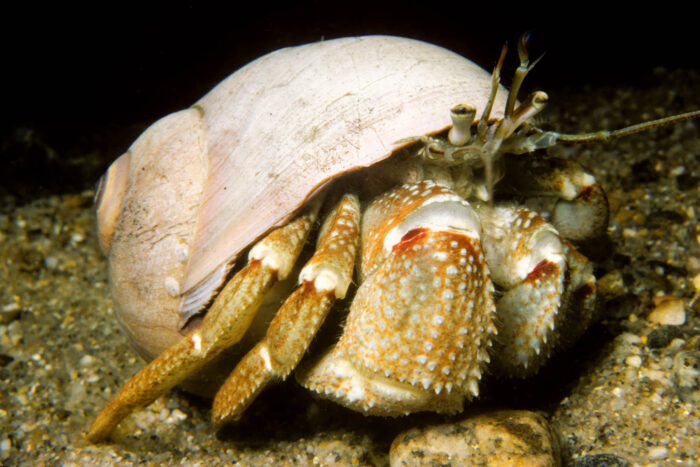Hermit crabs
Pagurus spp.
Hermit crabs are small crustaceans that lack a shell and must “borrow” one from another animal. They live on beaches, mud flats and shallow waters throughout the lower Chesapeake Bay.
This section shows one large critter image at a time. Use the thumbnails that follow to select a specific image to display here.

This gallery contains a grid of small thumbnails. Selecting a thumbnail will change the main image in the preceding section.
Appearance
Three species of hermit crabs can be found in the Chesapeake Bay:
- The long-clawed hermit crab, Pagurus longicarpus
- The broad-clawed hermit crab, Pagurus pollicaris
- The banded hermit crab, Pagurus annulipes
Hermit crabs lack a shell, so they will use an empty one that originally belonged to another animal, such as a snail, periwinkle or oyster drill. Their soft, coiled abdomen fits tightly inside the "borrowed" shell. The broad-clawed hermit crab is the Bay’s largest hermit crab. The banded hermit crab is the smallest. Hermit crabs have two pairs of walking legs.
One of a hermit crab's claws is larger than the other. Long-clawed hermit crabs have long, narrow claws. The hands of the claws have a darker stripe. Broad-clawed hermit crabs have a flat major claw with wart-like projections called tubercles. Banded hermit crabs have a hairy major claw. Their legs are banded with brown rings.
Feeding
Hermit crabs eat algae, detritus and other tiny particles.
Predators
Preyed upon by larger animals, including fish, blue crabs and large snails.
Reproduction and life cycle
Hermit crabs go through several stages before becoming adults. Eggs develop into tiny, free-swimming larvae called zoea. Zoea grow and molt several times before becoming megalops, which are still tiny but have a crustacean-like form. Megalops molt and grow into juveniles. Juveniles continue to molt and grow, eventually becoming adults. As hermit crabs grow, they find larger shells to “borrow.”
Did you know?
- It is nearly impossible to pull a hermit crab out of its shell. Hermit crabs wrap their soft abdomen around the inside of the shell to firmly hold themselves in place.
- Hermit crabs are always searching for a larger shell to borrow, and will sometimes steal a shell from a smaller hermit crab.
Sources and additional information
- Life in the Chesapeake Bay by Alice Jane Lippson and Robert L. Lippson
- Chesapeake Bay: Nature of the Estuary, A Field Guide by Christopher P. White
- Hermit Crabs - University of Rhode Island
